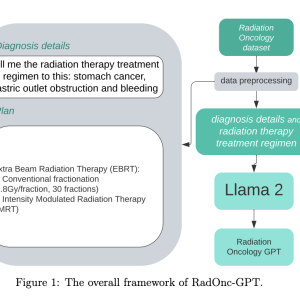

Large language models (LLMs) have emerged as powerful tools in the field of AI, transforming various industries through their capacity to comprehend and generate human-like text. From natural language understanding to text generation, LLMs such as GPT (Generative Pre-trained Transformer) models have revolutionized diverse fields, promising enhanced efficiency and innovation. However, In medicine, few fields require more precision or more data than radiation oncology. Patients’ lives depend on getting the right treatment in this specialized domain.
Mayo Clinic has developed a robust LLM called RadOnc-GPT, which utilizes Meta Llama 2 technology. This model has the potential to enhance the efficiency, precision, and overall effectiveness of decision-making in radiation therapy. It was trained using a substantial dataset comprised of patient records from Mayo Clinic’s radiation oncology department in Arizona. Importantly, patient data was securely handled within the clinic’s network, and the model was fine-tuned locally using a GPU server powered by Llama 2. All research involving this model is conducted with approval from an institutional review board.
“Properly fine-tuned, open source LLMs have immense potential to revolutionize radiation oncology and other highly specialized healthcare domains,” says Dr Wei Liu, Professor of Radiation Oncology and Research Director of the Division of Medical Physics, Mayo Clinic in Arizona.
The initial clinical application of RadOnc-GPT is focused on patient follow-up. Liu’s team intends to create a chatbot that can address common inquiries patients may have after undergoing radiotherapy. This initiative aims to lessen the burden on nurses and clinicians, allowing them to dedicate more time to higher-priority tasks.
Potential future advancements may involve extending RadOnc-GPT’s capabilities to encompass various clinical responsibilities, such as developing models to forecast patient outcomes in radiation oncology. Also, Liu mentions that the team is contemplating utilizing the recently launched and more sophisticated Llama 3 model to improve its effectiveness.
AI-driven tools streamline tasks, analyze intricate datasets swiftly, and uncover patterns that may elude human observation, allowing healthcare providers to focus on critical duties like direct patient care. The Mayo Clinic team collaborated with the University of Georgia on healthcare natural language processing, choosing Llama 2 as RadOnc-GPT’s foundation. This model is fine-tuned for tasks including generating treatment regimens, selecting radiation modalities, and providing diagnostic descriptions and International Statistical Classification of Diseases (ICD-10) codes based on patient data, enhancing specificity and clinical relevance. Extensive manual processing was undertaken to prepare the radiation oncology dataset, overcoming the challenges of data curation and extraction.
According to Liu, making advanced AI models open-source enables Mayo Clinic to utilize state-of-the-art models directly in its research, expediting the development process. This not only enhances patient care but also extends the initiative’s reach beyond precision in therapeutic interventions. Open-source AI systems are crucial in democratizing innovation, particularly for smaller companies and institutions. They facilitate the collective advancement of medical science by providing access to LLMs, even for organizations with limited resources to develop customized models.
In conclusion, the integration of LLMs like RadOnc-GPT into radiation oncology signifies a transformative leap in AI’s role in healthcare. Mayo Clinic’s development of RadOnc-GPT, utilizing Meta Llama 2 technology, promises enhanced precision and efficiency in treatment decision-making. Collaborative efforts with institutions like the University of Georgia highlight the potential for AI-driven tools to streamline patient care while democratizing innovation. By using open-source models and advancing research, Mayo Clinic is at the forefront of shaping a future where AI optimizes treatment outcomes.
The post RadOnc-GPT: Leveraging Meta Llama for a Pioneering Radiation Oncology Model appeared first on MarkTechPost.